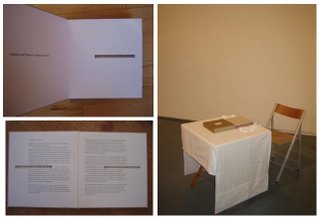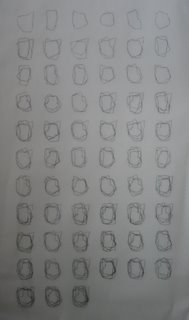Siún Hanrahan, Triptych Project
Tri-Angle
One of my responses to ∆ was ‘tri-angle’ – three angles or points of view. It offers a sense of the limits of dia-logue… The polarity of two risks the illusion that the full range of possibility is somehow captured in the space between them. Three marks the impossibility of this; it suggests différance.
A Tale of Bread, 2005

This piece explores the idea of conversation (rather than dialogue) and unfolded from the idea that: Bread is connectedness and communion and Conversation is connectedness and communion. Conversation is central to meaning as meaning emerges in the encounter with others. It is in and through conversation that identity is constructed.

A Tale of Bread takes the form of a book in three parts – Milling, Baking and Eating. Each part is built around a key moment in the tale of bread, from the processes by which it is made to the process by which it is consumed, and explores the intercourse of self and other in the emergence of meaning.

Some tales are told across all three parts and some belong to one part only. What is sought is a playful kneading of ideas, a kneading enacted within and between chapters.
Triúr: Elias, Benhabib and Burgess, a work in progress
The idea of three points of view (tri-angle) suggested a rather arbitrary beginning: the three books I have read most recently. Each of which is connected in a loose way with one question, 'how do I account for what is shared in meaning making?'
 Book I, Elias, offers some sense of the perspective offered by Elias, in his book The Society of Individuals, overlaid upon images drawn from previous work lifted into attention by Elias's metaphors.
Book I, Elias, offers some sense of the perspective offered by Elias, in his book The Society of Individuals, overlaid upon images drawn from previous work lifted into attention by Elias's metaphors.
Book II, Benhabib, will be like Book I in that its form will be determined in response to Benhabib's book The Situated Self.
Book III, Burgess (as for Benhabib).
One of my responses to ∆ was ‘tri-angle’ – three angles or points of view. It offers a sense of the limits of dia-logue… The polarity of two risks the illusion that the full range of possibility is somehow captured in the space between them. Three marks the impossibility of this; it suggests différance.
A Tale of Bread, 2005

This piece explores the idea of conversation (rather than dialogue) and unfolded from the idea that: Bread is connectedness and communion and Conversation is connectedness and communion. Conversation is central to meaning as meaning emerges in the encounter with others. It is in and through conversation that identity is constructed.

A Tale of Bread takes the form of a book in three parts – Milling, Baking and Eating. Each part is built around a key moment in the tale of bread, from the processes by which it is made to the process by which it is consumed, and explores the intercourse of self and other in the emergence of meaning.

Some tales are told across all three parts and some belong to one part only. What is sought is a playful kneading of ideas, a kneading enacted within and between chapters.
Triúr: Elias, Benhabib and Burgess, a work in progress
The idea of three points of view (tri-angle) suggested a rather arbitrary beginning: the three books I have read most recently. Each of which is connected in a loose way with one question, 'how do I account for what is shared in meaning making?'
 Book I, Elias, offers some sense of the perspective offered by Elias, in his book The Society of Individuals, overlaid upon images drawn from previous work lifted into attention by Elias's metaphors.
Book I, Elias, offers some sense of the perspective offered by Elias, in his book The Society of Individuals, overlaid upon images drawn from previous work lifted into attention by Elias's metaphors.Book II, Benhabib, will be like Book I in that its form will be determined in response to Benhabib's book The Situated Self.
Book III, Burgess (as for Benhabib).

0 Comments:
Post a Comment
Subscribe to Post Comments [Atom]
<< Home